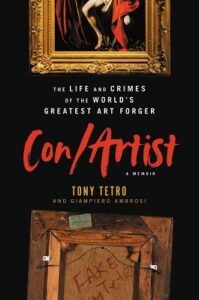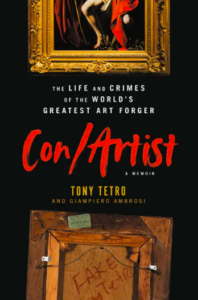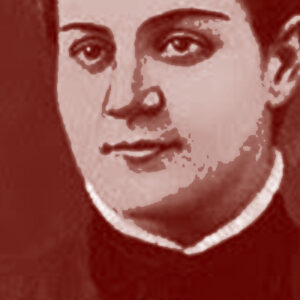One Sunday, like any other, I drove my beat-up Volkswagen Bug with no brakes to the Alpha Beta supermarket to buy bread and pasta, and to treat myself to a bruised, purple, manager’s special chuck steak. It didn’t seem like it then, but it was the day that changed my life and set me on the course I would pursue for the next fifty years.
I had finished shopping and was waiting around bored in the line at the check-out stand when I noticed a little circular book display. As I spun it around, something caught my eye, a book with a colorful Modigliani painting on the cover. It was Fake! by Clifford Irving. I picked it up and, as people streamed past me, I started reading, mesmerized by the story of the notorious Hungarian art forger Elmyr de Hory, who had had an illustrious twenty-year career as a European socialite selling Chagalls, Picassos, and Modiglianis to unsuspecting galleries and collectors in Spain, France, and Italy. I bought the book, drove home, and devoured it in one sitting, staying up late into the night. As I read, one idea became clearer and clearer: the only thing I could think was “I could do this.”
In the book, Irving talked about how Elmyr had risen from obscurity to become a respected dealer and sought-after guest at European summer homes. He had operated secretly, trading on a fictional personal relationship with the artists, and his main insight was to make paintings that weren’t exact copies but rather believable paintings in the style of the great masters and popular painters of the time. I thought it was brilliant that this guy had thought of doing these things and that he had the balls to carry it out with little more than his wits, his talent for art, and a plausible line of bullshit.
The very next morning, I resolved to put my own plan into action. I drove down to the big Art Deco library on Olive Street in downtown LA, where I searched the shelves for old, large-format art and architecture books whose pages were tinged with age. Usually, these books had three or four blank pages at the beginning and several more at the back. I would bury myself deep in the stacks and when no one was watching, cough and tear a blank page from the book. After a few trips and what must have seemed to others like a bout of tuberculosis, I had accumulated a little stack of paper, perfect for drawing.
My first steps were timid. Somewhere between a forgery and a prank. I was ignorant, but I was smart enough to know that an oil painting or anything by a major artist would draw attention. I also knew from Elmyr’s story that provenance—the history of who had owned an artwork and where it had been—could be a problem. So, rather than do a Chagall or Monet or Picasso painting, I decided to do a little drawing that was meant to be a fake Chagall, signed by de Hory, who, with the release of Fake!, had become notorious. I imagined that knowledgeable people in the art world would know who he was and would get a kick out of the piece of memorabilia. And since it wasn’t an actual, real work of art that would have been in a collection or museum, I wouldn’t need to come up with any kind of provenance. The idea seemed perfect.
The very first piece of art that I ever forged was a portrait of Chagall that I signed with the name of another forger.I searched books and found a self-portrait that Chagall had done. His was a simple black-ink line drawing showing his curly hair. Mine was based on that but a little more elaborate and had a donkey, one of his iconic symbols, on his head. I signed it, “À mon ami, Elmyr de Hory.” For three days, I practiced the drawing over and over again on regular art paper until I was finally happy and could do it without hesitation.
When I was done, I bought a sheet of plexiglass, which I held on my knees over a lamp like a poor man’s light table. Carefully, over and over, I practiced tracing my drawing until I could do it confidently. When I was finally ready, I took one of the pages I had torn from the library books and traced my work. When I finally stepped back to appraise the drawing, I was very happy with the result. And so it was that the very first piece of art that I ever forged was a portrait of Chagall that I signed with the name of another forger.
In those days, Palm Springs was glamorous and cosmopolitan, at the tail end of the Rat Pack era and the boom of modernist architecture. Many galleries on Palm Canyon Drive and Tahquitz-McCallum catered to a cultured and wealthy clientele, and it’s there that I decided to bring my work. I had concocted a story that my grandfather, old and in failing health, was giving his art away before he died and the collection ended up in probate. I said I was selling the art because my beat-up car needed a transmission. With my dying, brakeless VW Bug, it wasn’t too much of a stretch.
At first, I went to a few galleries, but the dealers weren’t interested or wanted to put my piece on consignment. I had had enough of that with my own art. Finally, I went into the gallery of John Mercante, a young, stylish, and charming guy. His gallery was full of beautiful works and I admired his suit and Gucci loafers, which he wore without socks—the kind of easy, relaxed elegance I associated with stylish, rich people in Palm Springs. As I showed him my Elmyr Chagall, we chatted about my grandfather and my backstory, and I felt like we had an easy rapport.
He liked the piece, got a kick out of the novelty, and offered me $200, though I asked for $400. He wrote me a check with a casual flourish, and as I left the gallery, he called after me, “Let me know if your grandfather has anything else.” That was it. It took fifteen minutes. This was incredible to me, to think that I could make a simple drawing and walk out with $200 after failing so miserably with my own art. Signed by me it was worthless; signed by a famous forger, it was worth money I could bank. The check Mercante had just written with such ease was twice my rent at the time. To celebrate, I went a half block down the street to treat myself to lunch at a nice restaurant.
As I sat there, I started to have second thoughts. If I cashed this check, I would have $200, but I would probably never be able to go back to Mercante, with whom I had developed a good feeling. I felt like we had hit it off and I had a sense that he could be my guide and teach me so many of the things that I didn’t know and would need to learn. I left my half-eaten sandwich, paid my bill, and headed back to the gallery.
When I walked in, Mercante was sitting with his feet up on his desk, bored in the middle of a weekday afternoon. He was surprised to see me back so soon. Sheepishly, I confessed what I had done and pleaded that he let me make paintings for him. I told him that I could come up with wonderful art that he would like and that he could make a lot of money on.
“First thing,” he said, “give me back that check.” I’m sure he was thinking, “What balls on this fucking kid,” but he wasn’t angry. Maybe he felt a little sorry for me or liked my hustle. I don’t know. I handed him the check and he gave me back my drawing. He told me that he wouldn’t buy any of my art, but if I wanted, I could bring it to him and he would tell me what he thought of it. He didn’t make a big deal or threaten to call the cops. I think he had a good business and didn’t want to jeopardize it. It was interesting to see that dealers would rather take a hit now and then than raise a big stink and spook their customers.
When I went home, I was happy. Despite the fact that I had not made any money, I felt like the day had been a big success. Mercante had liked my piece and had bought it, at least before I confessed. And though he didn’t want to buy my art afterward, he told me that I could bring him things to look at.
Now, I felt a real boost of confidence and was sure that I could take my Elmyr drawing anywhere. I drove to Beverly Hills and sold it to a place on Robertson. There, the old-time actor Vincent Price, who was known as an art connoisseur, looked at my piece and succinctly canned it. “I don’t like him,” he said, pointing to Elmyr’s name, “and I don’t like him,” pointing to Chagall’s. Despite Vincent’s scathing review, the owner took out a jeweler’s loupe, examined my drawing, and wrote me a check for $250. I gladly sank the money into back rent and bills that had just come due.
Having sold my first quasi-forgery, I was now ready to step up to the full-fledged thing. Too dumb to know any better, I decided to do a Modigliani, like the one that had caught my eye on the cover of Fake! An artist like that would have been too big, too significant for a clueless kid to have, but at least I was smart enough to do a pencil drawing instead of a painting.
In the 1920s Modigliani had done an oil painting of a nude woman on a bed that I had admired. I based my drawing on the same woman, but instead of lying down in bed, in my piece, she was sitting up. This made sense, as it could have been the preparatory drawing for the known painting. I did my drawing, tracing it as I had done with the Chagall, then signed it “Modigliani” and framed it in an inexpensive black frame.
Someone who really knows an artist can get a feeling just by looking at the whole thing. At the time, what did I know?Near me, there was a smorgasbord restaurant of the kind that was popular in the seventies, called Griswold’s. Attached to the restaurant, there was a motel, and then, I remembered, an art gallery. I knew that the guy there wouldn’t be an expert, but it was nearby and would be a low-risk way to check how I had done. The dealer liked the drawing, commenting on the strong and confident lines. Little did he know the lines were strong just because I had traced them instead of working freehand. I knew this guy was probably a three out of ten in knowledge, but still, his response told me I was on the right track.
A week later, my roommates, Don and Gary, planned to go to LA to see The Dinah Shore Show at CBS Studios on Beverly. I tagged along and asked them if they minded if we stopped on the way. I told them about my drawing and said they could come with me to Sotheby’s so they could see how it all went down. I wasn’t worried telling them; being a forger then was such a pie-in-the-sky idea that I didn’t mind if they knew. It seemed more like a prank that teenagers would do, like climbing a fence to go skinny-dipping, rather than a serious crime.
So, the three of us went to Sotheby’s, where I met with an appraiser while my friends browsed around the gallery. When I showed the drawing to the expert, giving him my story about my grandfather, he didn’t seem impressed. He examined the drawing for a while, then handed it back to me, saying, “It doesn’t feel right.” And that was it. There was no more to say. I felt like he had been too abrupt, but I said OK and left without an argument. At the time, I thought his statement was hokey, but he was right. Someone who really knows an artist can get a feeling just by looking at the whole thing. At the time, what did I know?
______________________________________________________________
Excerpted from Con/Artist: The Life and Crimes of the World’s Greatest Art Forger by Tony Tetro and Giampiero Ambrosi. Copyright © 2022. Available from Hachette Books, an imprint of Hachette Book Group, Inc.



















